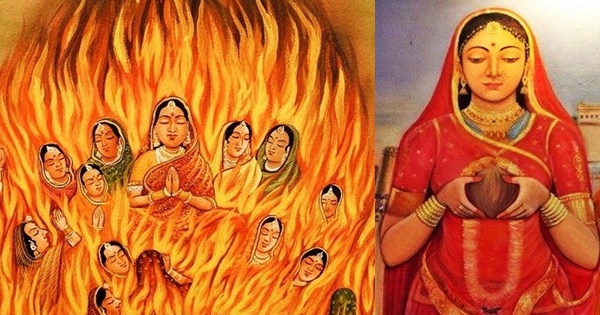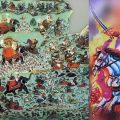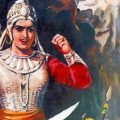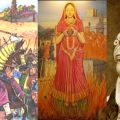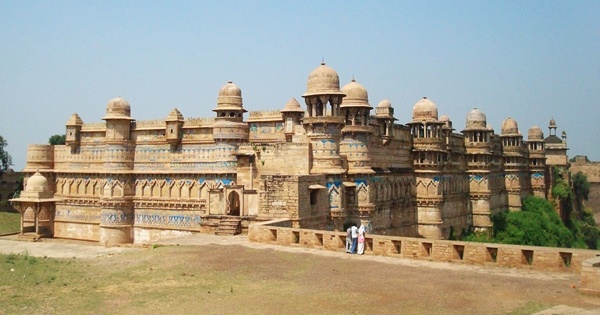What You May Not Know About Rani Lakshmibai of Jhansi
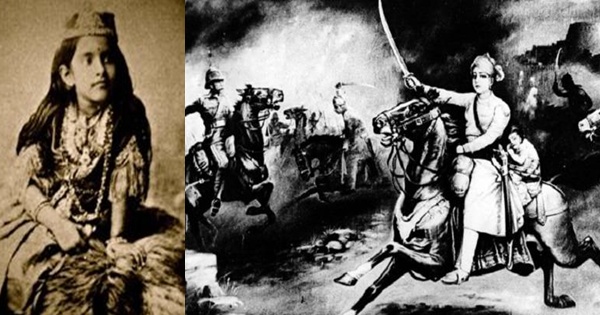
Motherless at 4, marriage at 14, mother at 23, widow at 25, rebel and defender of Jhansi at 29, battlefield warrior against British forces at 30, and martyrdom at 30! Lakshmibai was an inspiration for all freedom fighters, especially the women gentry from 1858 to 1947. The saga of the brave lady warrior is immortalized in golden letters in History.
Lakshmibai inspires us till today and shall continue to inspire future generations till eternity.
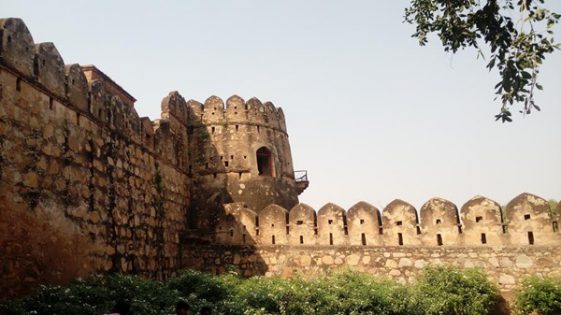
Rani Lakshmibai has been my inspiration since my childhood days. The very utterance of her name and Jhansi gets me goose bumps! When we planned our tour itinerary for Maihar, we included Jhansi in our list. After we visited Maihar, Khajuraho, Panna, and Ajaigarh, we headed for Orchha. Our Mahindra Thar had been our constant companion, taking us to places with me and my husband Yogaditya Singh Rawal driving in turns.
As our GPS signaled us that we had reached our destination Orchha, my joy knew no bounds. A day later, we would land up in Jhansi after a night’s stay and a full-day exploration in Orchha. Only 18 kilometers distanced us from the soil of the iron lady warrior we had always revered!
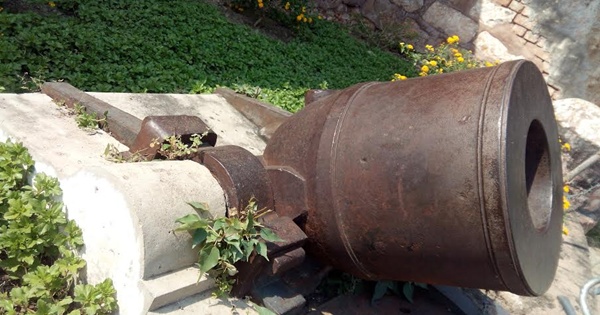
The moment soon arrived. And we landed up in her fortress standing robust at Bangira, a large hilltop. We hired a guide at the entrance. As we entered the fort premise, a mortar positioned in easy view welcomed us. The guide started narrating to us the saga of the valorous Maratha lady warrior Lakshmibai of Jhansi of Bundelkhand.
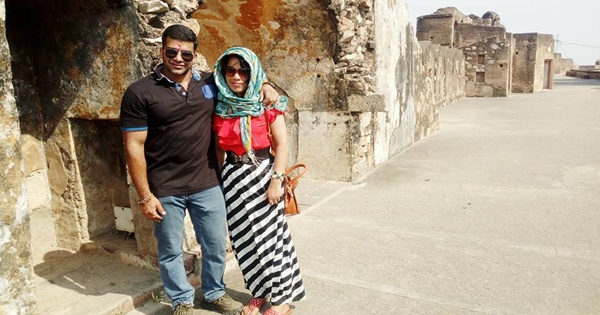
No one would have imagined that Manikarnika Tambe, as Lakshmibai was known before marriage, belonging to a simple Marathi Brahmin family from Varanasi, could weave a chronicle of valor, courage, queenship, and sacrifice.
Born on 19 November 1828, Manu (nickname) spent her early life in Varanasi. Her father Moropant Tambe worked in the court of Peshwa Baji Rao II of Bithoor in Kanpur. The last Peshwa of the Maratha Empire, Baji Rao II was banished to Bithoor by the British against an annual pension and an estate. Bithoor is located along the Ganga; it is the birthplace of Luv and Kush, the twin sons of Ram and Sita.

After Manu lost her mother Bhagirathi Bai at the age of four, the Peshwa of Bithoor brought her up as his own daughter. She started living at the Peshwa’s palace. The Peshwa named her Chhabili, which means playful. He facilitated her education the royal way at the palace. Soon she became proficient in horsemanship, fencing, shooting, use of the sword, unlike other children of her age.
The childless Peshwa Baji Rao II had adopted Nana Sahib (who played an instrumental role in the Revolt of 1857) and his younger brother as his sons. Manu and Nana Sahib became close playmates; together they learnt the art of warfare.

Local folklores and our guide’s narration acquainted us with an interesting story related to Nana Sahib and Manu during their childhood. Nana Sahib was four years older to Manu. Once, while riding his elephant, Nana Sahib refused to give in to Manu’s request for a ride. An offended Manu declared that one day she would own and have ten elephants to ride. No wonder, her declaration did come true soon! Even she didn’t think in her wildest of imaginations that she would be queen one day!!
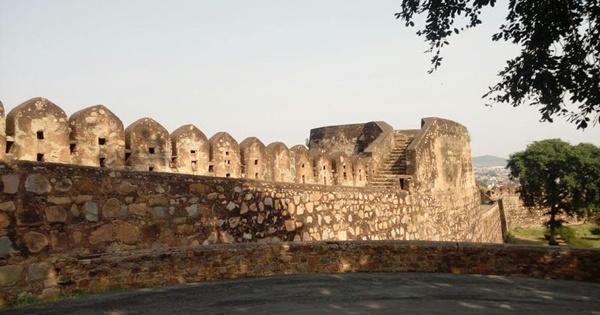
The king of Jhansi, Gangadhar Rao Newalkar, of Maratha lineage, happened to see Manu, then aged 14, riding a horse and practicing the sword. He was on a visit to Bithoor. He was so impressed by her boldness and beauty that he instantaneously decided to marry her. His first wife had died childless. Manu’s father and the Peshwa agreed to Gangadhar Rao’s marriage proposal though the king was older to Manu by several years.
The marriage was solemnized at the Ganesh Temple located within the premises of Jhansi Fort. Gangadhar Rao christened Manu’s name as Lakshmibai.
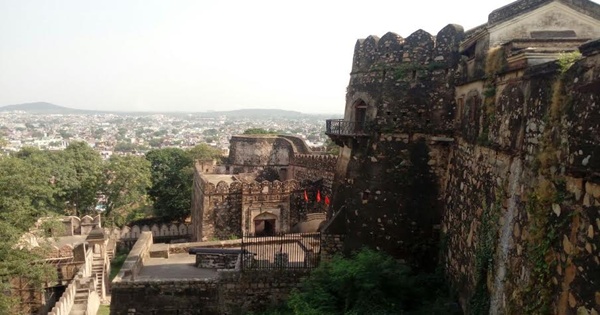
Ganesh Temple (small red flags) where Lakshmi Bai’s marriage was solemnized
Gangadhar Rao had been a statesman. Though Jhansi prospered under his regime, he was feared by one and all in his kingdom. For even the pettiest to the gravest of crimes, lawbreakers were hanged to death. Rani Lakshmibai stopped this practice.
The king followed her advice on administrative, judicial, and all matters related to his kingdom. Gangadhar Rao was an art and culture aficionado. He had a library that contained a huge collection of Sanskrit manuscripts. He regularly hosted theaters and himself participated in roles.
Jhansi had an army of around 5,000 men. Lakshmibai added a regiment of women. An excellent horse rider, she herself drilled and trained them. Her favorite horses were Sarangi, Pavan and Badal. Lakshmibai practiced regularly along with the women army. She allotted armed women guards at the women’s quarters in Jhansi.
One of the commandants of her women army was Jhalkaribai, who was her look-alike. Jhalkaribai was married to Puran Singh, an artillery man from the Jhansi army unit. During her childhood, she herded cattle and had no formal education. Like the Rani, she was brave and underwent training in war weapons and horse riding. She killed a leopard with a herding stick in the forest when she was young. Knowing about her exploits, Rani Lakshmibai appointed her and further trained her.
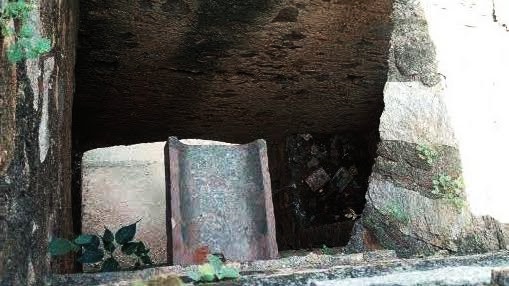
Area where lawbreakers were hanged
At the age of 23, Rani Lakshmibai gave birth to a son. He was named Damodar Rao. Rivalry within family members for succession to the throne led to the poisoning of Damodar Rao at four months of age. Subsequently, the child died.
Raghunath Rao (elder brother of Gangadhar Rao) was the immediate predecessor of Gangadhar Rao. After Raghunath Rao’s death, there emerged four contenders to the throne of Jhansi – Janki Bai, the widow of Raghunath; Kishan Rao and Gangadhar Rao, his brothers; and Ali Bahadur, the king’s illegitimate son. After Gangadhar Rao’s first wife died childless, hope prevailed amongst the remaining contenders. But Lakshmibai’s marriage with the king followed by birth of a son foiled their hopes. According to rumors that spread following the death of Damodar Rao and according to our guide’s narration, it was Lakshmibai’s brother-in-law and sister-in-law who played an active role in poisoning the child to death.

King Gangadhar Rao fell ill thereafter. Upon Rani Lakshmibai’s continuous request, the king, on his death-bed, adopted 5 year old Damodar Rao, a relative. Under the Doctrine of Lapse, the British annexed many kingdoms and principalities. Hence, to ensure that the adoption was proper and that Damodar Rao would be heir to the throne, three local British officials, namely Major Ellis, Captain Martin and a Political Agent, were called to witness the event. Gangadhar Rao died a day later, i.e. in November 1853.

After the king’s death, Rani Lakshmibai defied the norms of widowhood followed in the society. She neither broke her bangles nor dressed herself in white. She did not shave her head, as was customary for widows in most Hindu communities then. Besides, she limited her official mourning activities to the minimum and stayed indoors for only 13 days.

The British under Lord Dalhousie rejected Damodar Rao’s claim to the throne of Jhansi, as he was adopted. They applied the Doctrine of Lapse and annexed Jhansi to their empire. A year later, Rani Lakshmibai was entitled to a pension of Rs. 60,000 and allowed to stay in her palace at the fort.

In the early months of 1857, rumor about cartridges containing pork or beef fat being supplied by British sparked unrest amongst soldiers and the common men alike. And the first rebellion started in Meerut on May 10, 1857. The news reached Jhansi. The witty Lakshmibai sought permission from the British to raise a small force for her own protection. Her permission was granted.
Lakshmibai assembled the women of Jhansi and conducted a haldi kumkum ceremony, convincing them not to fear the British. She termed the British cowards. Nearly a month later, i.e. in June 1857, Indian soldiers of 12th Bengal Native Infantry seized Jhansi fort. They massacred the European officers of the garrison along with their wives and children. The soldiers left the fort after taking a large sum of money from the Rani. Immediately, Rani Lakshmibai assumed administration of Jhansi.
Meanwhile, a group of mutineers, who were supporters of a rival prince claiming the throne of Jhansi, attacked the fort. Rani Lakshmibai foiled their attempt, defeating them. The rulers of Orchha and Datiya, both allies of the British, attacked Jhansi in August 1857. They wished to divide Jhansi amongst themselves. Lakshmibai sought the help of the British, but in vain, as the latter considered her responsible for the massacre of Europeans at the fort.
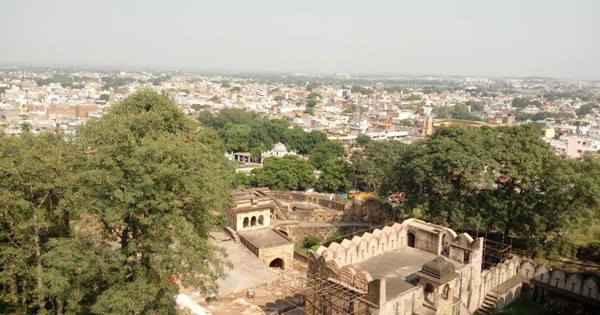
Rani Lakshmibai assembled her forces. She set up a foundry to cast cannons within the premises of the fort. Yes! She successfully defeated the invaders. Thereafter, Rani Lakshmibai ruled Jhansi peacefully from August 1857 to January 1858. She laid a strong defence of the fort with guns.
Towards the third week of March 1858, the British forces, under Commander Hugh Rose, marched towards Jhansi. They ordered the Rani to surrender and threatened destruction of the fort and the town if she refused.
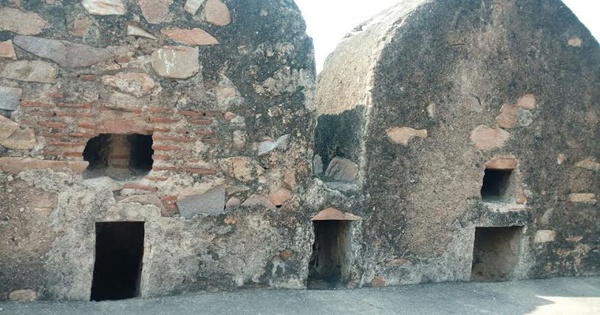
Walls of the fort from where fire could be directed at the enemy
These were the Lakshmibai’s motivating words to her forces: “We fight for independence. In the words of Lord Krishna, we will if we are victorious, enjoy the fruits of victory; if defeated and killed on the field of battle, we shall surely earn eternal glory and salvation.”

The area from where Rani Lakshmibai jumped down with Damodar tied to her back riding on Badal
The battle between Rani Lakshmibai and the British forces began on 24th March 1858. Tatya Tope, the Rani’s childhood playmate, marched towards Jhansi with 20,000 men to defend Jhansi, but he faced British troops on the way. The battle in Jhansi continued for 10 days until April 2nd. There were heavy casualties from both sides.
At last British forces were able to penetrate the walls of the fort and into the fort and the palace. Lakshmibai decided to run away from the fort to accumulate a force with the support of Tatya Tope and Rao Sahib (nephew of Nana Sahib). Learning about this, the witty Jhalkaribai (Lakshmibai’s lookalike), disguised as the queen, galloped in her horse towards the enemy. With her adopted son Damodar Rao tied to her back, Lakshmibai jumped down several feet from the fort, riding on Badal, one of her favorite horses. Badal died, while the two survived.
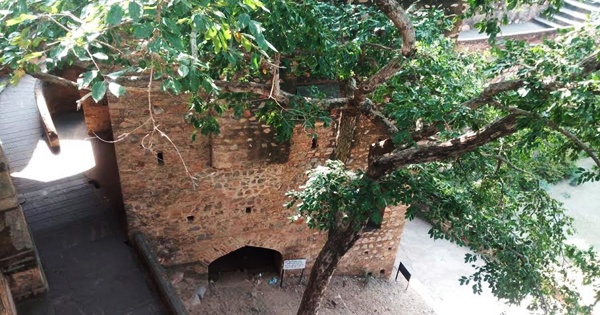
In the darkness of the night, Lakshmibai with her adopted son and escorted by nine of her warrior guards marched towards Pali to join Tatya Tope. Her guards were Kashi Bai, Moti Bai, Deewan Raghunath Singh, Khuda Bakhsh Basharat Ali (commandant), Deewan Jawahar Singh, Lala Bhau Bakshi, Gulam Gaus Khan, Sunder-Mundar, and Dost Khan. Jhalkaribai was caught and hanged to death by the British.
An alliance of four leaders, viz. Rani Lakshmibai, Rao Sahib, Nawab of Banda, and Tatya Tope occupied the town of Kalpi. The British forces attacked Kalpi on 22 May. In the fierce battle that took place, the Rani, who led the battle, was defeated. The four leaders fled to Gwalior and joined Indian freedom fighters, who took siege of the city. Maharaja Scindia had fled to Agra.
Nana Sahib was made the Peshwa of Gwalior. Rani Lakshmibai persuaded the leaders to get ready against a possible British attack, but in vain. On 16th June, the British attacked Gwalior.
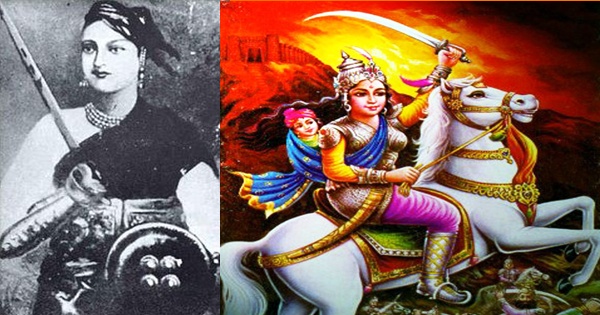
While Rani Lakshmibai was leaving Gwalior, she confronted the British forces near Phool Bagh, Gwalior. It was 17 June 1858. The Rani had worn a cavalry horse soldier’s (sowar’s) uniform. In the battle that ensued, most of her soldiers were martyred. While fighting with an enemy soldier, an wounded Rani Lakshmibai was unhorsed. She was further hit with sword and gun shots. Badly wounded, she managed to flee the battlefield, as she did not wish the British to touch her or capture her body.
Lakshmibai walked through a jungle where she met a hermit in his hut. Hearing enemy soldiers rushing towards the hermit’s hut, she requested the hermit to set the hut on fire, so as to burn her. The hermit gave in to her request. Later, the locals cremated her body. It was after three days that the British captured Gwalior.
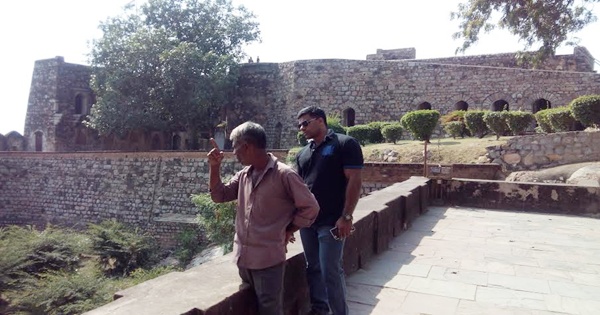
The guide’s narration got me goose bumps and brought tears to my eyes. I was factually transported to Varanasi where she was born, Bithoor where she was brought up by Peshwa Baji Rao II, Jhansi, and visualized all the battles.
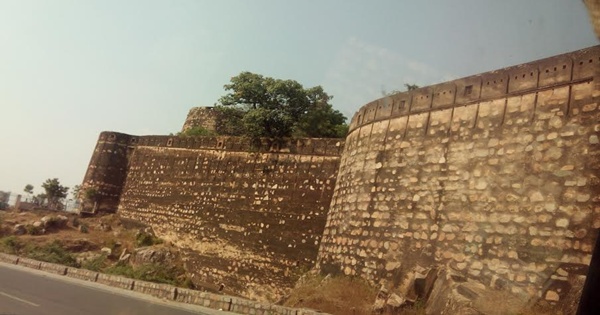
Such a brave warrior! I salute her gallantry. India salutes her heroism.
Read my travelogues on Maihar and Khajuraho and take an informative visual tour of these two of the most visited places in Madhya Pradesh.

